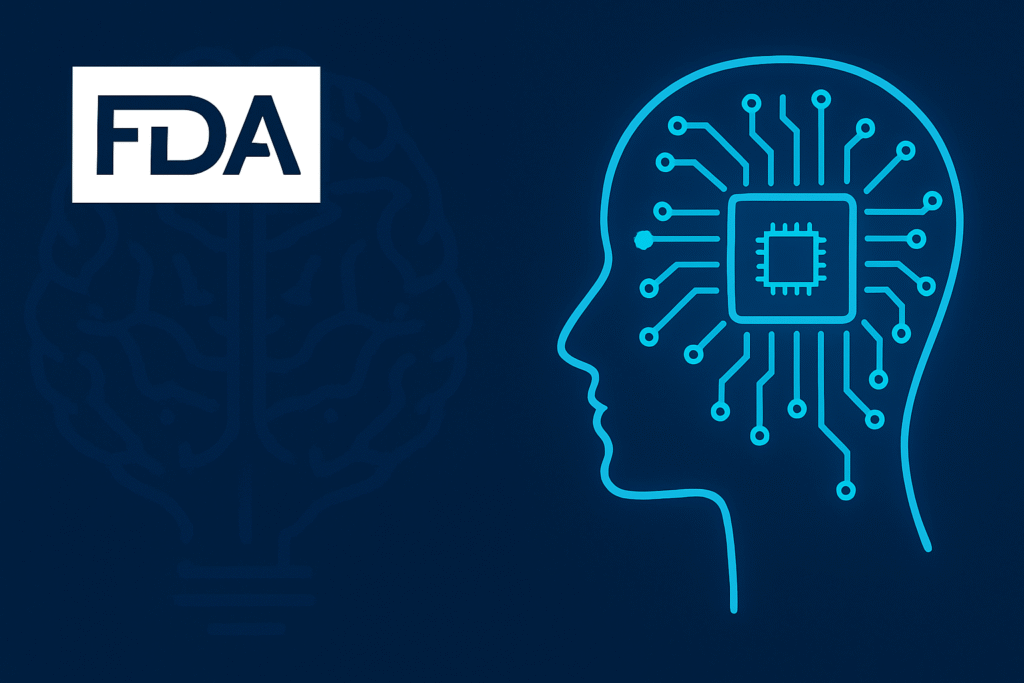
FDA AI regulation in healthcare is undergoing a major transformation. The U.S. Food and Drug Administration is quietly reshaping how artificial intelligence is governed in medicine — a shift that could influence everything from how your doctor diagnoses illness to how your Apple Watch monitors your heart.
AI has already become a powerful force in medicine, helping spot tumors in X-rays, flag potential strokes, and detect diabetic eye disease without a doctor. Just as AI in drug discovery is reshaping R&D, AI-powered diagnostics are transforming how care is delivered at the point of need. But until recently, the FDA lacked a clear framework for regulating these dynamic, constantly evolving systems.
Now, that’s changing — subtly, but significantly.
From Static Devices to Living Algorithms
The FDA regulates a category called Software as a Medical Device (SaMD) — tools that perform medical functions but exist purely as software. These aren’t embedded in machines like pacemakers or MRIs; they live in apps, in the cloud, or on your wearable device.
The FDA adopted the SaMD framework in 2016, aligning with International Medical Device Regulators Forum (IMDRF) standards. Since then, it has cleared dozens of AI-powered SaMD products — like IDx-DR, which detects diabetic retinopathy without human input, and Apple’s ECG app, which alerts users to irregular heart rhythms.
But AI introduces a regulatory dilemma: many of these tools are designed to learn and improve over time. And historically, the FDA has used a static approval process — one that assumes a product won’t change after clearance. That model works for scalpels and thermometers, but not for AI systems that retrain themselves weekly.
This is the regulatory gap the FDA is now trying to close.
Enter the Predetermined Change Control Plan (PCCP)
To address this, the FDA has introduced the concept of a Predetermined Change Control Plan (PCCP). Think of it as an AI product’s evolving playbook — submitted before market launch.
A PCCP lays out:
- What aspects of the algorithm will change (e.g., model weights, thresholds)
- How those changes will be tested and validated
- When the FDA must be notified again (e.g., performance drops)
For instance, a cardiac risk model might retrain monthly on fresh patient data, so long as it maintains at least 95% accuracy. If accuracy falls below that threshold, the FDA requires re-engagement. This enables safe iteration without a full re-approval process each time — a big leap toward aligning regulatory frameworks with how AI actually works.
Good Machine Learning Practices (GMLP): Building a Trustworthy Foundation
Flexibility in updates only works if the original model is robust. That’s where Good Machine Learning Practices (GMLP) come in — a set of principles developed jointly by regulators in the U.S., Canada, and the U.K.
GMLP ensures AI systems are:
- Fair: Trained on diverse, representative datasets
- Reliable: Validated across clinical scenarios
- Transparent: Interpretable to clinicians
It’s not enough for AI to be accurate. It must also be safe, equitable, and understandable — especially when lives are on the line.
Real-World Performance Monitoring: AI Doesn’t Stop Learning
Even the best model can go off-course in the real world. That’s why the FDA is emphasizing Real-World Performance Monitoring — ongoing surveillance that catches problems early.
This approach tracks how AI performs across different settings and populations, flagging issues like:
- Performance drift
- Unexpected failures
- Emerging data bias
Instead of a one-and-done approval, this creates a lifecycle approach — where regulation evolves alongside the product.
A New Era of Lifecycle Oversight
These three pillars — PCCP, GMLP, and Real-World Monitoring — signal a profound change in the FDA’s approach to AI:
- From static to dynamic regulation
- From premarket clearance to postmarket accountability
- From single-device approval to holistic lifecycle governance
This isn’t just a policy tweak. It’s a foundational shift that will shape how hospitals, developers, and patients engage with AI tools for years to come. This shift marks a new era for FDA AI regulation in healthcare, with lifecycle oversight at its core.
What the Future Holds for FDA AI Regulation in Healthcare
As this regulatory model gains traction, companies will need to bake compliance into their development process — not tack it on afterward. As FDA AI regulation in healthcare continues to evolve, developers must build with compliance in mind — from day one.
Expect to see:
- AI tools that comply with evolving FDA AI regulation in healthcare
- AI tools that update more safely and frequently
- Greater transparency for clinicians using AI in diagnostics
- Stricter postmarket requirements — and more public scrutiny
More importantly, the FDA’s approach could become a global standard, influencing how AI in healthcare is regulated worldwide.
🧠 What Is SaMD?
Software as a Medical Device (SaMD) refers to software intended to diagnose, treat, or prevent disease — without being part of a hardware medical device.
Examples include:
- Mobile apps that assess heart rhythm
- Cloud-based platforms that interpret medical images
- AI tools that recommend treatment paths
📊 Traditional vs. AI-Driven Medical Devices
| Feature | Traditional Devices | AI-Powered SaMD |
|---|---|---|
| Approval Type | Static | Adaptive |
| Postmarket Monitoring | Limited | Continuous |
| Risk Model | Predictable | Dynamic |
📅 Timeline: FDA AI Oversight
- 2016 – FDA adopts international SaMD framework
- 2019 – Formal discussions begin on AI/ML-based SaMD
- 2021 – Good Machine Learning Practices (GMLP) drafted
- 2023–2024 – Predetermined Change Control Plan (PCCP) framework solidifies
📬 Want More Like This?
If you want research-backed breakdowns on AI, healthcare, and regulation, subscribe to our blog:
Should we regulate AI like software, like medicine… or something entirely new?
📬 Join 100+ life sciences professionals getting monthly AI insights. No spam, just signal.
